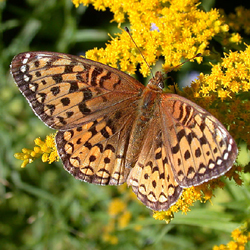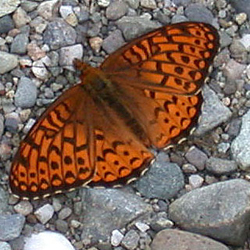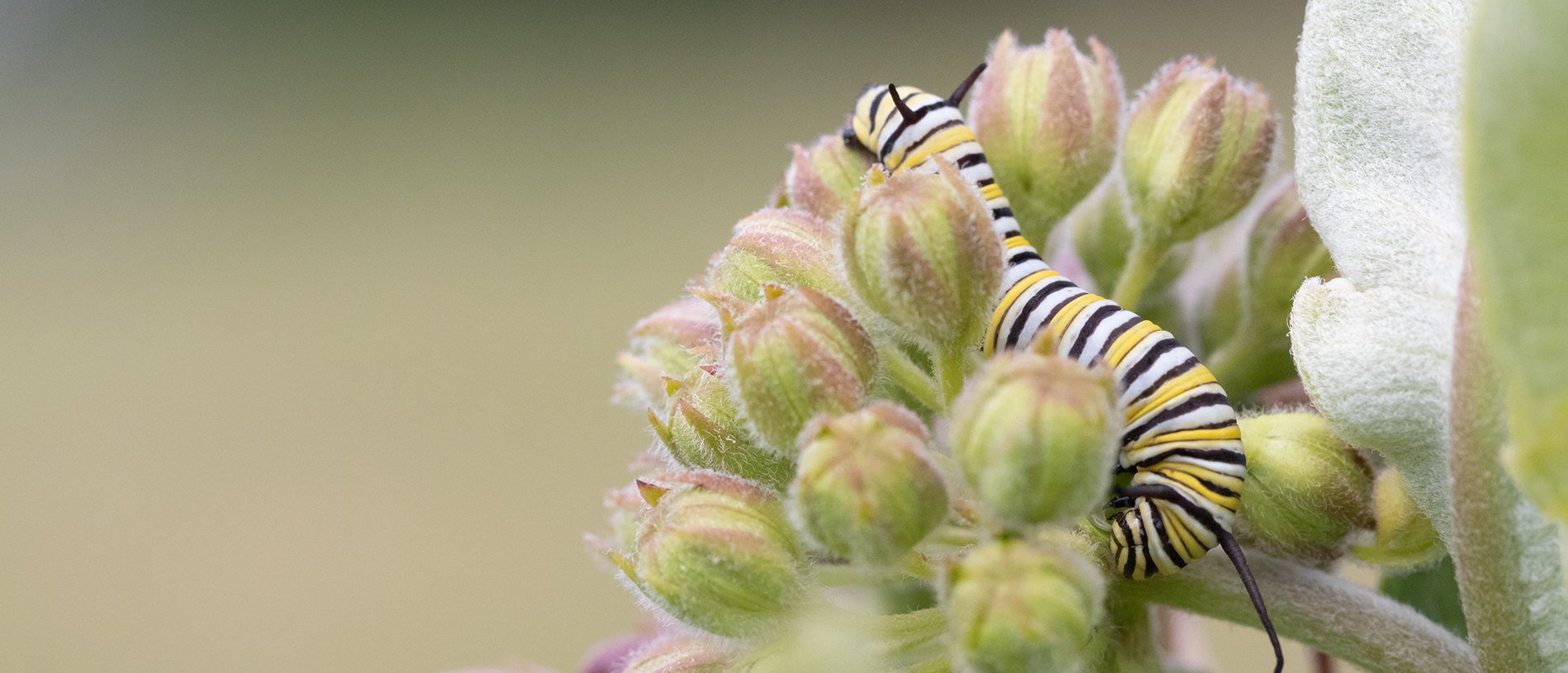Find a Butterfly
Atlantis Fritillary
Speyeria atlantis
Named
Edwards, 1862

Identification
Wingspan: 1 3/4 - 2 5/8". The smallest and darkest of our three larger (Speyeria) fritillaries. The best single field mark is the very dark outer margin of the wings above. In the two larger species this margin consists of a well-defined black double line; in Atlantis the lines are fused and "smudged". The hind wing below is very dark, almost purple in tone compared to the more reddish color of Aphrodite. For a detailed comparison of the three species, see under Great Spangled Fritillary. The restricted distribution of this species in the northern and western regions of the state especially at higher elevations is another aid to identification. In addition to the preceeding points, male Atlantis Fritillaries may be distinguishable by smell! - see Notes.
Distribution
A northern and mountain species that occurs continent-wide from Alaska south in the Sierra Nevada and Rockies to California, Arizona and New Mexico, east across the coniferous forest zone to Labrador and south in the Appalachians to Virginia and West Virginia. Ranges throughout northern New England south in the Berkshires to Connecticut.
Status in Massachusetts
Common to locally abundant at higher elevations in the western part of the state east to the Connecticut Valley. Several single specimens, presumably vagrants, have been taken recently east of the Connecticut Valley: 22 August 1995, Ashburnham (Worcester Co.), R. Forster; August 1995, Athol (Worcester Co.), D. Small. Historically reported in eastern Massachusetts at Lynn, Essex, and Stoneham (Farquhar 1934). Scudder regarded Atlantis as uncommon in Massachusetts, and it is possible that the species has increased with the gradual return of forested glades, which it prefers to broad open fields. However Tudor (pers.comm.) says that it is certainly not increasing in New Jersey and the Hudson Valley and speculates that it has retreated northward with the warming climate. Maximum: 550, October Mountain (Berkshire Co.) during 4th of July Count.

Flight Period in Massachusetts
A single flight period from mid- June to mid-September; mainly July through August. Extreme dates: June 15, 1987, Windsor (Berkshire Co.), E. Neumuth; 12 September 1994, Heath (Franklin Co.), D. Potter.
Larval Food Plants
Violets. Northern Blue Violet (V. septentrionalis) may be a favored food plant in New England. It has also been recorded on the white Canada Violet (V. canadensis).
Adult Food sources
Recorded on a wide variety of common flowers; also attracted to mud, rotting vegetation, carrion and excrement; "offal of any description" in Edward‘s words (Scudder, 1889).

Habitat
Open habitats, but more typically associated with woodlands and wetlands than Great Spangled or Aphrodite, i.e. tends to favor glades, openings, wet meadows, bogs, roadsides and wooded stream banks over broad upland pastures.
Life Cycle
EGG: Yellow becoming heavily flecked with reddish brown or tan; dome-shaped, open at the top with 12-13 vertical ribs and many finer lateral ribs covered with minute punctures. OVIPOSITION: Eggs are laid singly on or near the food plant in late August, hatching in 15-17 days. LARVA: Dark "velvety" purple above; a little lighter below, covered with long bristly spines which are reddish at the base;color has also been described as greenish yellow to greenish gray with a black line down the back and gray bristles with reddish bases (Scott, 1986); once emerged from hibernation, the caterpillar feeds for about 50 days before pupation. CHRYSALIS: Brown with black blotches and wrinkled; PUPATION: The chrysalis is suspended head downward by a silken holdfast, typically attached on the underside of a log or similar location. OVERWINTERING STAGE: First instar larva.
Males chase females until the latter land with wings closed. The male then lands in front of or beside the female and flicks his wings "in quick bursts...to waft his pheromone to her antennae, and then he moves alongside her and they join." (Scott, 1986).
Notes
Scudder (1889) was impressed by this species‘ strong odor "which I found it difficult to determine; it seemed to me at first to have somewhat the fragrance of the pine woods; but on applying to Miss Soule, she at once said it was the odor of sandal-wood, which exactly describes it. She added that specimens she had brought into her room at the mountain hotel made it seem close, and a friend who called inquired on entering: "Why! do you bring your sandal-wood box up here?" This distinctive smell is produced by the males as part of the courtship ritual (See above) by rubbing specialized scent scales (androconia) on the wings.
Account Author
Chris Leahy



